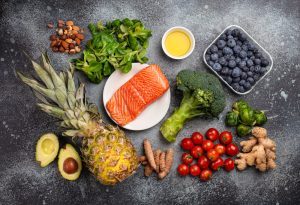
Choosing an Anti-Inflammatory Diet for a Healthy Back
When it comes to healing your body, there is a lot you can do, including adjusting your diet. The foods you eat have a significant impact on the state of your body. Choosing an anti-inflammatory diet can help to reduce back pain.
What Is an Anti-Inflammatory Diet?
Inflammation is the body’s natural response to illness, injury, or anything else harming the body. However, raised levels of inflammation can be a problem. An anti-inflammatory diet can reduce levels of inflammation in the body. This diet is focused on choosing foods that won’t exacerbate inflammation. Processed foods and foods high in sugar tend to increase inflammation while natural, whole foods reduce it.
Connection Between Inflammation and Back Pain
Since inflammation is a part of the healing process, it is inevitable that you will have some inflammation when you experience back pain. The inflammation you feel occurs because the body is trying to repair its injuries and prevent future illness. If you have a back injury, a herniated disc, or strain, the inflammation can last much longer. This is called chronic inflammation, and it occurs when the body is not able to heal the root cause of the pain. With chronic inflammation, you feel inflammation and pain for an extended period of time. Addressing the root of the issue is essential; but, until then, you can ease the symptoms by implementing an anti-inflammatory diet.
Eating a Variety of Fruits and Vegetables
The key to the anti-inflammatory diet is getting as many vitamins and minerals as you can. These nutrients fuel the body so it can function properly. Your body will begin healing itself and the nutrients will help reduce the levels of inflammation. Fruits and vegetables are excellent sources of vitamins and minerals. However, you shouldn’t just stick with a few fruits and vegetables that you like. You need to be eating a variety. As you prepare your food, try to eat a colorful assortment of fresh foods. Include plenty of dark, leafy greens. Try a few new foods of varying colors. Eating a variety ensures you get higher levels of all the nutrients you need.
Getting Omega-3s
Many people don’t eat high levels of Omega-3 fatty acids, but they are highly beneficial. Several studies have found that eating omega-3s helps to fight inflammation in the body. You can get omega-3s from several sources. It is commonly found in fish and seafood. Salmon is particularly high in omega-3s. If you don’t enjoy fish or seafood, you can also take supplements. However, omega-3s are also found in nuts and seeds. Adding more of these to your diet is easy. You can include nuts and seeds in many different recipes: topped on salads, incorporated into whole-grain bread, soaked and pureed in smoothies, etc.
Healthy Fats
Your body needs fats in order to function well and to decrease inflammation. Therefore, you need to make sure you are giving your body healthy fats. Foods with healthy fats may be higher in calories, but they provide your body with needed nutrients. One of the most popular healthy fats is found in avocados. Avocados are tasty and easy to find. You can include avocados in many meals, preparing them differently each time: added in sandwiches, topped on toast, pureed in smoothies, mashed for a veggie dip, or even thrown into brownies (you won’t know they are there)! You can also get healthy fats from eggs, nuts, seeds, olive oil, yogurt, and certain cheeses.
Changing what foods you give your body can have a high impact on the way your body functions. To address your back pain, reduce the number of processed foods you are eating and focus on eating nutrient-dense foods. A quick search on the internet will provide you with plenty of great recipes–even those for picky eaters!
While a change in diet is helpful, you should also seek treatment to address the true cause of your back problems. Click here to learn more about treatments available at The Nerve & Disc Institute!